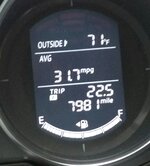Actually, that is absolutely NOT true. People believe this because there's a difference between the idea of an engine's 'efficiency' and it's MPG. 'Efficiency' means that you are getting the most 'work' out of the fuel that you are burning. At small throttle openings, the temperature of the burning air/fuel mixture is lower than it is at higher throttle openings. It's not just lower because there's less fuel burned, it's even lower than that. In part because of heat transfer to the piston, cylinder, and head. There's also 'pumping losses'. You get the absolute most work/efficiency out of an engine at it's torque peak. That's where the charge's burn temp is highest, and where the engine recovers the most energy from the burned fuel. It's also not the best place for MPG.
With carbureted engines, the air/fuel ratio *had to* be richer than the 'ideal' 12:1 (ish) at smaller throttle openings, just to get the non-homogeneous mixture to ignite and (mostly) burn. With FI engines, this is improved but is still somewhat of a factor. Stratified-charge engines improve this situation. So does DI.
But we are talking about *miles* per *gallon*, not efficiency. The slower you drive, the higher your MPG. You can check my previous postings for a mpg/mph graph. In your head, add another data point - 30 mph on a flat road nets me 45 mpg on the fuel economy gauge. When you accelerate slower, you are at a slower average MPH for the trip. And your MPG is higher. Think of it from the opposite direction: drag-racing starts obviously use more fuel.
I've spent most of the last 20 years commuting long distances, and that afforded me the opportunity to test various driving techniques on a Mitsu Eclipse turbo AWD, Subaru Outback, Audi A4 turbo AWD, Subie Impreza CVT AWD. Slow accel ALWAYS gave me significantly better mileage (up to 5 mpg for a trip that was netting 34-36 mpg over the course of a full tank of fuel). (Short-shifting to keep the engine near the torque peak didn't reverse the wasted gas of higher acceleration rates.) Slower top speeds was the number one way of significantly increasing mileage, and coasting to stop signs was a very distant third in effect.
About a decade ago, I read an article about a Toyota engine design that lugged the engine at as slow an RPM as needed, to provide the acceleration rate requested by the driver, *while running the throttle wide-open*. That maximized engine *efficiency* with higher burn temps, better fuel homogenization, and lower pumping losses.

